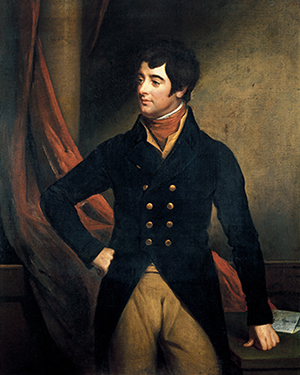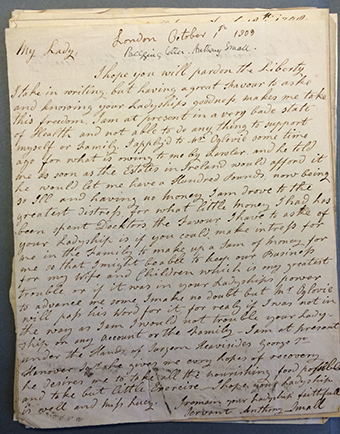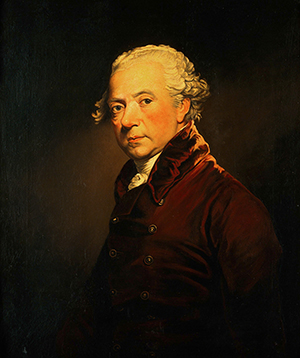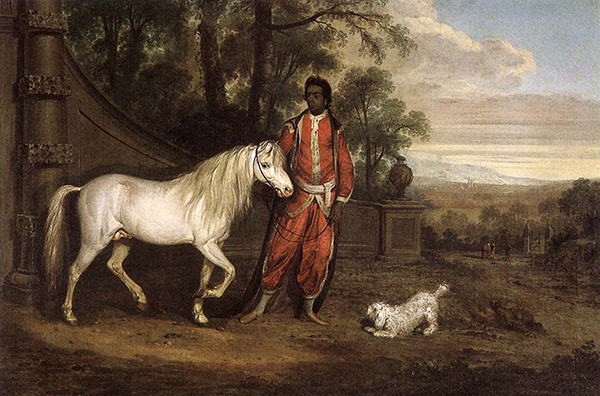‘Every man is exactly what he makes himself’
Published in Features, Issue 6 (November/December 2020), Volume 28Who was Tony Small, friend and manservant of Lord Edward Fitzgerald? And what became of him and his family after Fitzgerald’s death in 1798?
By Laura McKenna

Above: Lord Edward Fitzgerald—as an eighteen-year-old lieutenant in the 19th Regiment of Foot, he was left for dead on the battlefield of Eutaw Springs, South Carolina, in September 1781, until rescued by an escaped slave, Tony Small. (NGI)
The Battle of Eutaw Springs in South Carolina in September 1781 was one of the last of the Revolutionary War and one of the bloodiest. Among those left for dead was Lord Edward Fitzgerald, the fifth son of the duke of Leinster, illegitimately descended from King Charles II, and a lieutenant in the 19th Regiment of Foot. Tony Small, an escaped slave, carried him from the battlefield and cared for him until he was well enough to rejoin his regiment. Both were around eighteen when they met, and thereafter Tony worked as Fitzgerald’s groom and then his manservant. He died within six years of Fitzgerald. In her excellent biography, Citizen Lord, Stella Tillyard speculates about his children’s children, ‘lost forever to history’.
There is scant direct information about Tony Small’s origins, whether he made the middle passage or was born in South Carolina. In the years of the Revolutionary War, many thousands of slaves took the decision to run following the 1775 Offer of Emancipation by Lord Dunmore, then governor of Virginia, to all who came over to the British side. Perhaps Tony was already attached to the regiment, or was hiding out and scavenging on the battlefield when he found the injured Lt. Fitzgerald. He probably made a very pragmatic decision to join him as his servant, at Charleston, before sailing for the West Indies in May 1782. The two men travelled between Jamaica, Antigua, St Lucia and Martinique, before arriving in Ireland in 1783.
Life with Lord Edward

Above: The letter from ‘Anthony Small’ requesting the payment of £100 owed to him from the Fitzgerald estate, after he had fallen ill in London in October 1803. (NLI)
Throughout Fitzgerald’s correspondence with his family there are frequent mentions of Tony. These shed light on the nature of Tony’s relationship with Fitzgerald and his family and put him at the heart of the Fitzgerald household. At first, it seems that Tony’s role was to be that of a groom. Over the next few years he became Lord Edward’s manservant and an important figure in his life. When stationed in Woolwich, which he termed a ‘nasty stinking little town’, Fitzgerald declared that there is ‘not a soul I care about except poor Tony’. He had arranged to send Tony to London to learn to dress hair but changed his mind, saying, ‘I could not do without one friendly face to look at, one that I felt to love a little’. Tony became the most constant person in Fitzgerald’s life, accompanying him on his journeys through Europe and North America, where he is referred to as ‘faithful Tony’.
In 1788, after a thwarted love affair, Lord Edward joined the 54th Regiment and sailed, together with Tony, for Halifax in Nova Scotia. This was the beginning of an incredible journey for the pair, one that crystallised Fitzgerald’s critical views on hierarchical society and his belief in the equality of man. Halifax in 1788 must have been a place of great interest to Tony. It was the site of resettlement for thousands of free ‘loyalist’ blacks, who were promised plots of land and initial funding to help them get established. Inevitably, what they received fell far short of what was promised, and many endured great suffering in the harsh winters. Fitzgerald made frequent mention of Tony in his correspondence during their eighteen months in North America, which included an extraordinary journey down the Mississippi. Impressed by the simple, equitable life of the Canadian settlers, Fitzgerald commented: ‘The equality of everybody and their manner of life I like very much. There are no gentlemen, everybody is on a footing.’
During the 1790s Lord Edward married Pamela de Genlis, considered at the time to be the daughter of the duc d’Orléans. They settled in Kildare in a small lodge. In this intimate household, Tony met and married Julia, who was nursemaid to the Fitzgeralds’ first-born child. Within a year Tony had a son of his own, also named Edward. There are accounts of their ‘democratic’ lifestyle, with Tony and the other servants joining the Fitzgeralds and their visitors for dances and jigs.
By 1798, however, Lord Edward’s balancing act between his radical plans and his domestic life was at an end. An order was made for his arrest in March. When the officers turned up at Leinster House to search for Fitzgerald, Tony managed to alert him and help him escape. For the next two months he remained on the run, hidden in Dublin, before he was shot while being arrested on 18 May, dying of his wounds the following month.
Tony’s character
It is possible to glean hints of Tony’s character from Lord Edward’s letters. He serves as a counterpoint to Fitzgerald’s impulsive, romantic nature, and is careful with money. In Spain he cautions Fitzgerald against taking an expensive coach to join the family in the Pyrenees: ‘It was to cost me forty pounds, but Tony … insisted I was very foolish when I might go for 5 guineas, in short he prevailed’. In Canada, with winter setting in and not a lot to spend money on, Fitzgerald jokes about Tony: ‘I have found he has one fault, he is avaricious; he begins to count the money both he and I are to save’.
Tony reminds Fitzgerald to write to his mother (having apparently been told to do so by the duchess) and engages in his discussions on family and political matters. In 1788 Fitzgerald, then disappointed in his ambitions for promotion, writes somewhat sourly of his brother Robert, whose political affiliations were opposed to his own: ‘Tony says that if Lord Robert goes on the way he is doing, he will soon be a major’. In their early years together, Fitzgerald comments, ‘if only Tony could write’. At some point he must have learned to, as there is a letter in his hand in the National Library (above page).
Life after Lord Edward

Above: John Heavisides, surgeon-extraordinary to King George III, was engaged by Tony Small when he fell ill, an indication that Small and his family were reasonably well off up to that point.
Following the death of Lord Edward, his widow Pamela moved to Hamburg to live with her cousin. Tony and Julia accompanied her, taking with them their own son, Edward. They remained with Pamela until after she married the American consul, Mr Pitcairn, returning to London early in 1801.
The reasons were probably twofold. Pamela had little money. Her pension was terminated with the guillotining of the duc d’Orléans in 1793, and the Act of Attainder following Lord Edward’s death saw his estates confiscated and his children disinherited. There may not have been enough to keep on two employees. Indeed, three years previously one of the Fitzgerald family had commented on ‘her family [being] too large for her purse’, at which point there was only a ‘lady’s maid, Mrs Small and a girl, and Mr Small and 2 boys for errands’. It is quite likely, too, that Tony and Julia wanted to live independently. Pamela arranged for passports for the couple, stating that Julia wished to work as a femme-de-chambre or seamstress. She also expressed her reservations about Julia’s suitability for the post of lady’s maid on account of her ‘impertinence’.
The family settled in or near Air Street, Piccadilly, then a busy, respectable place combining living accommodation with businesses such as silversmiths, engravers, a linen draper, an undertaker, a bookseller, a hair manufacturer and a wine merchant. St James, Piccadilly, their parish church, where their children were baptised, had abolitionist associations. (Ottobah Cugoano, the Ghanaian abolitionist, was baptised there in 1773.)
Unfortunately, the family did not enjoy their independence for very long. By 1803 Tony was ill and his business in difficulty, and an advertisement suggests that Julia was seeking work as a lady’s maid. It seems that she could speak English, French and German. Tony wrote a letter (previous page?) to one of the Fitzgerald sisters in October 1803, asking for some money to tide him over in lieu of what was owed to him from the Fitzgerald family—he was seeking the considerable sum of £100 of this from William Ogilvie, Lord Edward’s stepfather, who managed his estate. It seems that the money was tied up somehow in Edward’s lands in Kildare, in particular with lands leased to Richard Lawler. Ogilvie had written back to Tony, informing him that he would have the £100 as soon as the estates in Ireland could afford it, so it was clearly Tony’s money.
Tony wrote of his financial woes to Jerry O’Leary, the manservant of Arthur O’Connor, at the time a prisoner in Fort George. And, showing just how significant Tony had been in the Fitzgerald family, O’Connor wrote to Lucy Fitzgerald, Lord Edward’s sister, alluding to the family not helping him out.
Up until his illness, it seems that Tony and his family were reasonably well off. They clearly had some entitlement to money from Ireland and they had a business. When Tony engaged a doctor to attend him, he did not choose a local apothecary but John Heavisides, who was at the time surgeon-extraordinary to the king. He was unable to help Tony beyond prescribing rest and nourishing food.
Tony was 40 years old when he died in 1804, six years after Lord Edward. He is buried, most likely, at St Mary’s churchyard in Wimbledon. There is a record of a will for ‘Mr Anthony Small, a manservant of London’, in the Dublin Prerogative Court Index but unfortunately no will exists, possibly another casualty of the fire at the Public Records Office in 1922.
What of Tony’s descendants?
There is some confusion over the names of Tony’s children. The name Moirico is quoted in various articles and books and can apparently be traced back to a letter quoted in a 1905 book, La Belle Pamela. Pamela mentions a child, Moirico, in her cousin’s household in Hamburg, writing that ‘that child gets uglier every day’. A footnote to this suggests—without any supporting evidence (other than, perhaps, prejudice)—that this was probably the Smalls’ mulatto child. There is no mention of Moirico prior to this, nor any subsequent mentions in primary sources.
Genealogical sources suggest instead that Tony and Julia had two children: Edward, born in December 1795—birthplace listed as Ireland—and Harriet Pamela, born in December 1798, clearly named after their friends and employers.
Harriet Pamela married in 1817 but her husband deserted her within ten years, leaving her to look after her surviving child alone—a son, also named Edward. Sadly, this Edward had several convictions for assault and larceny before being transported in 1838 at the age of twenty to Port Arthur in Tasmania, where he drowned six years later. His record in the prison colony is a grim account of infringements and punishment, including hard labour in chains. Harriet Pamela seems to have been made of stern stuff. In 1859 she was one of the first applicants to the Courts for Divorce and Matrimonial Causes for the protection of her property under the new Matrimonial Causes Act.
Tony’s son, Edward, worked as a customs locker in the bonded warehouses on the Thames. He married in 1830, had five children and died in 1878. One of his daughters, Elizabeth, emigrated to New Zealand, where she married and has many descendants. She died in 1933 at the age of 93.

Above: This painting by Thomas Roberts (1748–78) has often been considered a portrait of Tony Small. It was originally in the Carton collection and was apparently labelled ‘Tony and his White Pony’. The talented and prolific Roberts, however, had already died of consumption by the time Tony Small arrived in Ireland in 1783. Instead, it is far more likely to be the painting by Roberts exhibited at the Society of Artists of Ireland in 1772 (no. 69) and designated Portrait of bold Sir William (a Barb), an East Indian black, and a French dog, in the possession of Gerald Fitzgerald Esq. The painting has the requisite symbols of exoticism and luxury befitting Roberts’s patron, the duke of Leinster—a Berber horse from North Africa, an East Indian servant in rich robes and golden slippers, and a ‘French’ dog. Gerald, Lord Edward’s younger brother, was only six at the time this portrait was painted, and it’s to be hoped that only the pony and dog were actually in his possession. (Private collection)
Conclusion
The first mention of Tony in the Fitzgerald correspondence is as ‘a poor black’ when he had just escaped slavery. He was ‘poor Tony’ in his early years as a groom before the journey through North America as Fitzgerald’s companion, when he became ‘faithful Tony’. By 1796 Lady Pamela refers to him as ‘Mr Small’. It is interesting to note that he signed himself ‘Anthony Small’ in his letter and is designated as such in his will and on his children’s baptismal certificates, perhaps reflecting his independence and his desire to choose his name for himself, to be something other than ‘faithful Tony’, though faithful he undoubtedly was.
Whatever his name and his origins before slavery, Tony Small was a much-travelled literate man, able to converse in French and most likely German, after living there for over two years. He was pragmatic, competent, careful with money and opinionated, as was his wife, the impertinent Julia.
‘Every man is exactly what he makes himself’—these are Lord Edward’s words on observing what he took to be a democratic and equitable life in Canada. It seems that Tony Small pursued an independent life but was hampered by his very loyalty to the Fitzgerald family, their failure to release the money owed to him, and the illness that deprived him first of his livelihood and then of his life at the age of 40.
Laura McKenna’s novel, Words to shape my name, based on the life of Tony Small, will be published in January 2021 by New Island Books.
READ MORE:
Africans in late eighteenth-century Ireland
FURTHER READING
W.A. Hart, ‘Africans in eighteenth-century Ireland’, Irish Historical Studies 129 (May 2002).
N. Rodgers, Ireland, slavery and anti-slavery: 1612–1865 (London, 2007).
S. Tillyard, Citizen Lord: Edward Fitzgerald, 1763–1798 (London, 1997).
















